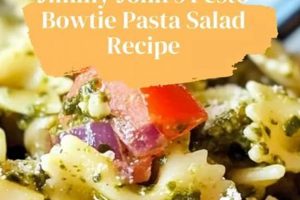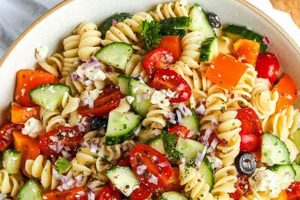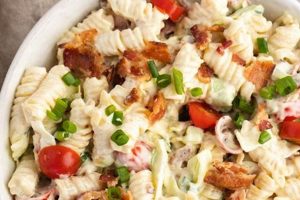Cold pasta salads incorporating diced ham are a popular dish, often served as a side at picnics, potlucks, and barbecues. These dishes typically feature cooked pasta, ham, vegetables, and a creamy or vinaigrette-based dressing. Variations can include different pasta shapes, cheeses, and additional protein sources like hard-boiled eggs.
The versatility and convenience of these salads contribute to their widespread appeal. They can be prepared in advance, are easily transportable, and offer a balance of carbohydrates, protein, and fats. Furthermore, they offer a refreshing and flavorful option, particularly during warmer months. The adaptability of the basic formula allows for customization based on dietary needs and preferences, using gluten-free pasta or substituting ingredients for vegan or vegetarian alternatives.
This article will delve into the art of crafting the perfect pasta salad with ham, exploring variations in ingredients, dressings, and preparation techniques to elevate this classic dish from simple to spectacular.
Tips for Creating Exceptional Ham and Pasta Salad
Elevating a simple pasta salad with ham into a culinary delight involves attention to detail and thoughtful ingredient selection. These tips offer guidance for achieving optimal flavor and texture.
Tip 1: Cook Pasta Al Dente: Pasta cooked to a firm, “to the tooth” texture holds its shape better in the salad and prevents a mushy final product. Slightly undercook the pasta according to package directions.
Tip 2: Chill Ingredients Thoroughly: Using chilled pasta and other ingredients helps the dressing adhere and prevents it from becoming watery. Cool the pasta quickly under cold water after draining.
Tip 3: Select High-Quality Ham: The ham’s flavor is central to the dish. Opt for a high-quality ham, such as Black Forest or honey ham, for a richer, more nuanced taste. Cubing the ham ensures even distribution throughout the salad.
Tip 4: Balance Flavors and Textures: Incorporate a variety of vegetables to add contrasting textures and flavors. Crisp vegetables like bell peppers, celery, and red onion complement the softness of the pasta and ham.
Tip 5: Choose the Right Dressing: The dressing ties the salad together. A creamy dressing, like mayonnaise-based, offers richness, while a vinaigrette provides a lighter, tangier flavor profile. Consider using a homemade dressing for maximum flavor control.
Tip 6: Add Cheese for Complexity: Cheese adds another layer of flavor and texture. Cubed cheddar, crumbled feta, or shredded provolone are excellent choices.
Tip 7: Season Appropriately: Enhance the flavors with fresh herbs, such as parsley, chives, or dill. Season with salt and pepper to taste, adjusting according to the saltiness of the ham and other ingredients.
Tip 8: Allow Flavors to Meld: Allowing the salad to chill for at least 30 minutes before serving allows the flavors to blend and develop fully.
By following these tips, one can create a ham and pasta salad that is not only visually appealing but also offers a delightful balance of flavors and textures.
The following section will provide specific recipe examples demonstrating these principles in action.
1. Pasta Variety
Pasta variety plays a crucial role in the overall success of a ham and pasta salad recipe. Different pasta shapes offer varying textures and abilities to hold dressing, significantly impacting the final dish’s flavor and experience. Short, sturdy pasta shapes like rotini, farfalle (bowties), and fusilli hold dressing effectively due to their ridges and crevices. This ensures each bite is flavorful and prevents the dressing from pooling at the bottom of the bowl. Conversely, longer strands like spaghetti or linguine, while acceptable, may not hold the dressing as efficiently, potentially leading to a less cohesive and flavorful salad.
The pasta’s size also influences the salad’s aesthetic appeal and ease of consumption. Smaller shapes like ditalini or orzo create a delicate presentation suitable for elegant occasions, while larger shapes provide a more substantial feel, perfect for casual gatherings. Choosing a pasta shape that complements the other ingredients is essential. For example, a robust, ridged pasta like radiatore pairs well with a chunky dressing and larger pieces of ham and vegetables, while a smaller, smoother pasta like elbow macaroni suits a creamier dressing and finely diced ingredients. Matching pasta shape to ingredient size creates textural harmony.
Understanding the impact of pasta variety allows for informed decisions when creating ham and pasta salad recipes. Selecting the appropriate shape enhances both the visual appeal and the overall culinary experience. Considerations extend beyond simple aesthetics and practicality, impacting flavor distribution and enjoyment. By carefully choosing the pasta, one ensures a well-balanced, flavorful, and visually appealing salad.
2. Ham Selection
Ham selection significantly influences the overall flavor profile of ham and pasta salad. The chosen ham’s inherent qualitiessaltiness, smokiness, sweetness, and texturedirectly impact the final dish. A salty, heavily smoked ham, such as Black Forest ham, contributes a robust flavor that complements bolder ingredients like sharp cheddar cheese and Dijon mustard. Conversely, a milder ham, like honey ham, allows other flavors in the salad, such as delicate vegetables and herbs, to shine. The ham’s texture also plays a role; a thicker cut provides a more substantial bite, while thinly sliced or diced ham integrates seamlessly with the pasta and other components. Consideration of these factors ensures a balanced and flavorful result.
Choosing the appropriate ham involves evaluating the recipe’s other ingredients. For a salad featuring robust flavors, a stronger ham provides a complementary base. In salads with lighter, fresher elements, a milder ham prevents overpowering more delicate flavors. Practical examples include pairing Black Forest ham with Swiss cheese, caraway seeds, and a Dijon vinaigrette for a heartier salad. A lighter honey ham pairs well with fresh vegetables like cucumbers, bell peppers, and a lemon-herb vinaigrette. These pairings demonstrate how ham selection can either enhance or diminish the overall balance and complexity of the salad.
Careful ham selection is integral to crafting a well-balanced and flavorful ham and pasta salad. Understanding the interplay between ham type and other ingredients allows for informed decisions that optimize taste and texture. This awareness elevates the salad from a simple combination of ingredients to a cohesive, flavorful dish. By considering the ham’s characteristics and its interaction with other components, one ensures a successful and satisfying culinary experience.
3. Vegetable Choices
Vegetable choices significantly impact the flavor, texture, and nutritional value of ham and pasta salad. Thoughtful selection elevates the dish from simple to complex, creating a balanced and satisfying culinary experience. Considerations include color, texture, flavor compatibility with ham and chosen dressing, and overall nutritional contribution.
- Color and Visual Appeal
Vibrant vegetables enhance the salad’s visual appeal, stimulating appetite and adding to the overall presentation. Red bell peppers, cherry tomatoes, and green peas provide contrasting colors against the backdrop of pasta and ham. Consideration of color balance creates a visually engaging dish that is as appealing to the eye as it is to the palate.
- Texture and Mouthfeel
Varying textures create a more dynamic and enjoyable eating experience. Crisp vegetables like celery, cucumbers, and red onion provide a refreshing contrast to the softer textures of pasta and ham. Inclusion of both soft and crisp elements adds depth and complexity to each bite, enhancing overall enjoyment.
- Flavor Compatibility
Vegetable flavors should complement the ham and chosen dressing. Sweet corn and peas pair well with honey ham and a light vinaigrette. Black olives, pepperoncini, and artichoke hearts complement bolder hams like Black Forest and robust dressings. Harmonizing flavors create a cohesive dish where each element contributes to a unified taste profile.
- Nutritional Value
Incorporating nutrient-rich vegetables maximizes the salad’s health benefits. Broccoli florets, spinach, and chopped carrots contribute vitamins, minerals, and fiber, elevating the nutritional profile beyond simple carbohydrates and protein. Thoughtful vegetable selection adds nutritional value to the dish, making it a healthier and more satisfying meal option.
Strategic vegetable choices create a ham and pasta salad that is not only visually appealing and texturally interesting but also nutritionally balanced and flavorful. The interplay between vegetable characteristics and other ingredients, such as ham and dressing, determines the overall success of the dish. Careful selection ensures a well-rounded, satisfying, and visually appealing culinary experience.
4. Dressing Type
Dressing type is a pivotal element in ham and pasta salad recipes, significantly influencing the overall flavor profile and textural experience. The dressing acts as a unifying agent, binding the ingredients and imparting a cohesive taste. Selecting the appropriate dressing requires consideration of the other components, such as the ham’s saltiness and smokiness, the vegetables’ sweetness or acidity, and the desired final flavor profile.
- Creamy Dressings
Creamy dressings, often mayonnaise-based, provide richness and a smooth mouthfeel. Variations include classic mayonnaise, ranch, and creamy Italian. These dressings complement milder hams and pair well with ingredients like celery, peas, and hard-boiled eggs. A creamy dressing coats the pasta and other components, creating a luxurious texture and a milder flavor profile. However, creamy dressings can become heavy, especially in warm weather, and may not be suitable for all palates.
- Vinaigrettes
Vinaigrettes offer a lighter, tangier alternative to creamy dressings. Common examples include balsamic, red wine, and lemon-herb vinaigrettes. Their acidity cuts through richer ingredients like ham and cheese, providing a refreshing counterpoint. Vinaigrettes are particularly suitable for salads featuring fresh vegetables like tomatoes, cucumbers, and bell peppers. They offer a brighter, more acidic flavor profile and are generally lighter than creamy options.
- Mustard-Based Dressings
Mustard-based dressings provide a tangy and slightly spicy element. Honey mustard and Dijon mustard dressings are common examples. These dressings complement bolder hams, such as Black Forest ham, and pair well with ingredients like Swiss cheese and caraway seeds. They offer a unique flavor profile that balances sweetness and tanginess, adding complexity to the salad.
- Herb-Infused Dressings
Herb-infused dressings can be either creamy or vinaigrette-based, with the addition of fresh herbs like parsley, dill, chives, or oregano. The herbs add a fresh, aromatic element that enhances the overall flavor profile. Herb-infused dressings pair well with a variety of ingredients and can be tailored to complement both mild and bolder hams and vegetable combinations. They offer a versatile option for adding depth and complexity to the salad.
Careful consideration of dressing type ensures a harmonious balance of flavors and textures in ham and pasta salad. Matching the dressing to the other ingredients creates a cohesive dish where each element complements the others. Understanding the characteristics of different dressing types allows for informed decisions that elevate the salad from simple to exceptional. The interplay between the dressing, ham, vegetables, and other components ultimately determines the overall culinary experience.
5. Flavor Enhancements
Flavor enhancements play a crucial role in elevating ham and pasta salad recipes from simple to exceptional. These additions contribute depth, complexity, and balance, transforming the overall sensory experience. Strategic incorporation of herbs, spices, cheeses, and other flavorful elements creates a more nuanced and satisfying dish. The careful selection and application of flavor enhancers allows for customization and personalization, catering to individual preferences and dietary needs.
Fresh herbs provide brightness and aromatic complexity. Parsley, dill, chives, and oregano impart distinct flavor profiles that complement both mild and bolder hams. Spices like black pepper, paprika, and garlic powder add warmth and depth. The judicious use of spices can enhance the ham’s smokiness or create a contrasting flavor dimension. Cheese selection contributes significantly to the overall flavor profile. Sharp cheddar adds a tangy bite, while feta provides a salty, creamy element. Other flavor enhancers, such as chopped nuts, sun-dried tomatoes, or olives, introduce textural and flavor complexity. For example, toasted slivered almonds provide a satisfying crunch and nutty flavor, while sun-dried tomatoes offer a burst of umami. These additions create a multi-layered sensory experience, enhancing the enjoyment of the salad.
Effective flavor enhancement requires careful consideration of balance and proportion. Overuse can lead to overpowering flavors, while insufficient amounts may fail to make a noticeable impact. Understanding the interplay of different flavor profiles is essential for achieving a harmonious and balanced final product. The ham’s inherent flavor characteristics, the chosen vegetables, and the dressing type all influence the choice and quantity of flavor enhancers. A thoughtful approach to flavor enhancement transforms a simple ham and pasta salad into a culinary delight, demonstrating the significant impact of these seemingly minor additions.
6. Chilling Time
Chilling time is a crucial, often overlooked, element in ham and pasta salad recipes. It significantly impacts flavor development and overall enjoyment. Sufficient chilling allows the flavors of the various componentsham, pasta, vegetables, and dressingto meld and harmonize, creating a more cohesive and flavorful final product. This chilling period also improves the salad’s texture, as the pasta absorbs the dressing more thoroughly, resulting in a more satisfying mouthfeel. Understanding the importance of chilling time is essential for achieving optimal results.
- Flavor Development
Chilling allows the individual flavors of the ingredients to blend and mature. The ham’s saltiness and smokiness permeate the pasta and vegetables, while the dressing’s acidity and herbs infuse the other components. This melding of flavors creates a more complex and balanced taste profile compared to a freshly made salad. The longer the chilling time, the more pronounced this flavor integration becomes, up to a point. Over-chilling can lead to undesirable textural changes.
- Texture Enhancement
Chilling firms the pasta and allows it to absorb the dressing more effectively. This leads to a more palatable texture and prevents the salad from becoming soggy or watery. The chilling process also enhances the crispness of the vegetables, contributing to a more satisfying overall mouthfeel. The ideal chilling time depends on the pasta shape and the dressing’s consistency. A longer chilling time may be necessary for denser pasta shapes and thicker dressings.
- Temperature and Palatability
A chilled pasta salad is more refreshing and palatable, especially in warmer weather. The cool temperature enhances the flavors and provides a welcome contrast to the richness of the ham and dressing. Serving the salad at the appropriate temperature maximizes enjoyment and contributes to a more satisfying dining experience. Over-chilling, however, can dull the flavors and make the salad less appealing.
- Food Safety
Chilling is essential for food safety, particularly for salads containing mayonnaise-based dressings. Harmful bacteria can multiply rapidly at room temperature. Proper chilling inhibits bacterial growth, ensuring the salad remains safe for consumption. Adhering to recommended food safety guidelines regarding chilling times minimizes the risk of foodborne illnesses.
Chilling time is an integral part of the ham and pasta salad preparation process. It is not merely a matter of convenience but a critical step that significantly influences the final dish’s flavor, texture, and safety. Understanding the impact of chilling time and implementing appropriate chilling practices ensures a more enjoyable and safer culinary experience. Ignoring this crucial step compromises the overall quality and potentially the safety of the salad.
Frequently Asked Questions
This section addresses common inquiries regarding ham and pasta salad preparation, offering practical guidance for achieving optimal results.
Question 1: What type of pasta is best suited for ham and pasta salad?
Short, sturdy pasta shapes like rotini, farfalle, and fusilli hold dressing well and maintain their shape. Longer pasta can become unwieldy and may not distribute the dressing evenly.
Question 2: Can different types of ham be used?
Ham selection significantly influences the overall flavor profile. Black Forest ham offers a smoky, robust flavor, while honey ham provides a sweeter, milder taste. Choose a ham that complements the other ingredients and desired flavor profile.
Question 3: How can the salad be made more nutritious?
Incorporating nutrient-rich vegetables like broccoli, spinach, and bell peppers enhances the salad’s vitamin and mineral content. Adding legumes, such as chickpeas or black beans, increases protein and fiber.
Question 4: What is the best way to prevent the salad from becoming watery?
Ensure all ingredients, including the pasta and vegetables, are thoroughly chilled before combining. Cooking the pasta al dente prevents it from becoming overly soft and absorbing excess moisture. Dress the salad shortly before serving to minimize water accumulation.
Question 5: How long can ham and pasta salad be stored?
Properly stored in an airtight container in the refrigerator, ham and pasta salad typically lasts for three to five days. Discard the salad if it develops an off odor or appearance.
Question 6: Can ham and pasta salad be frozen?
Freezing is generally not recommended, as it can negatively impact the texture of the pasta and vegetables. Mayonnaise-based dressings may also separate upon thawing, resulting in an undesirable consistency.
Addressing these common questions provides a foundation for successful ham and pasta salad preparation. Attention to detail and careful ingredient selection ensures a delicious and satisfying culinary experience.
The following section will explore variations on the classic ham and pasta salad recipe, offering creative inspiration for customizing this versatile dish.
Conclusion
Exploration of ham and pasta salad recipes reveals a dish offering remarkable versatility and adaptability. Careful selection of pasta shape, ham type, vegetables, and dressing creates a balanced and flavorful culinary experience. Attention to detail, such as cooking pasta al dente, chilling ingredients thoroughly, and allowing flavors to meld, elevates the dish from simple to exceptional. The potential for customization, incorporating diverse ingredients and flavor enhancements, makes ham and pasta salad suitable for a wide array of occasions and palates. Proper storage practices ensure food safety and maintain optimal quality.
Ham and pasta salad, often perceived as a simple picnic fare, offers significant culinary potential. Understanding the interplay of ingredients and techniques allows for the creation of a dish that is both satisfying and sophisticated. Continued exploration of flavor combinations and presentations ensures this classic dish remains a timeless and adaptable culinary staple.






